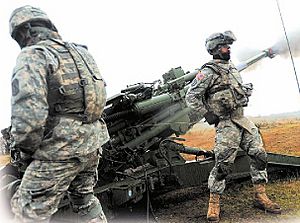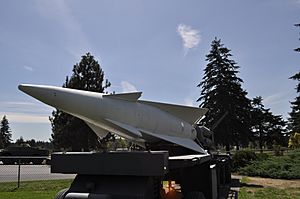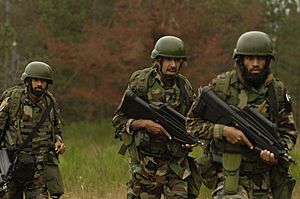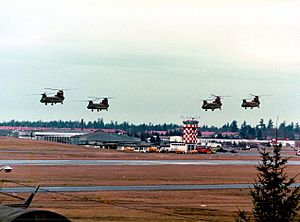Fort Lewis facts for kids
Quick facts for kids Fort Lewis |
|
|---|---|
| Part of United States Army I Corps United States Army I Corps |
|
| Located near: Tacoma, Washington | |

17th Field Artillery Brigade Fort Lewis
|
|
| Coordinates | 47°06′21″N 122°33′52″W / 47.10583°N 122.56444°W |
| Site information | |
| Controlled by | United States Army |
| Site history | |
| Built | 1917 |
| In use | 1917–present |
| Garrison information | |
| Garrison | Headquarters and Headquarters Company, Joint Base Garrison (US Army) U.S. Army IMCOM U.S. Army IMCOM |
Fort Lewis is a large military base in the United States. It is located about 9 miles (14.6 km) southwest of Tacoma, Washington. This base is managed by the United States Army Joint Base Garrison.
On February 1, 2010, Fort Lewis joined with the United States Air Force's McChord Air Force Base. They became one big base called Joint Base Lewis–McChord (JBLM). This change happened because of recommendations from the Base Realignment and Closure Commission in 2005.
JBLM is a key place for training and getting military units ready. It's the only Army base west of the Rocky Mountains that can quickly send out large forces. Its location is great because it's close to major ports like Tacoma, Olympia, and Seattle. This makes it easy to ship equipment. Troops can also fly out from McChord Field, and smaller groups can use Sea-Tac Airport nearby. Air Force units at JBLM can perform important missions using their C-17 Globemaster III planes.
Contents
What is Joint Base Lewis-McChord?
The Joint Base Garrison is the team that runs JBLM. They support all the military units, families, and other people connected to the base. Their main goal is to help soldiers train and get ready for missions. They also work to make JBLM a great place for soldiers and their families to live.
The base is led by an Army commander and an Air Force deputy commander. They manage many departments that provide services like a city. These services include building maintenance, fun activities, family programs, training support, and emergency help.
Some of the main groups that help run the base are:
- Public Works: They handle buildings and roads.
- Logistics: They manage supplies and equipment.
- Family and Morale, Welfare and Recreation: They organize activities and support for families.
- Human Resources: They help with personnel matters.
- Emergency Services: They provide police, fire, and medical help.
- Plans and Training Security and Plans: They plan for future operations and safety.
Other teams also help, like the Public Affairs Office, which shares information. The Religious Support Office provides spiritual care. The Resource Management Office handles money. The Equal Employment Opportunity Office ensures fair treatment. The Installation Safety Office focuses on safety.
Three military units also help the Joint Base Garrison:
- The 1st Joint Mobilization Brigade helps reserve units from all military branches get ready for missions.
- The 627th Air Base Group oversees Airmen who support the base.
- The Headquarters and Headquarters Company helps Army personnel on the base and new soldiers when they arrive.
Soldiers at JBLM get medical care at places like Madigan Army Medical Center. Airmen get care at the McChord Clinic and Madigan Army Medical Center.
JBLM Main and JBLM North Areas
JBLM is home to over 25,000 soldiers and civilian workers. The base also supports more than 120,000 retired military members and 29,000 family members. The main part of Fort Lewis covers 86,000 acres (350 km²). The Yakima Training Center, a separate area, is much larger at 324,000 acres (1,310 km²).
JBLM Main and North have many excellent training areas. These include 115 live-fire ranges where soldiers can practice shooting. More training space is available at the Yakima Training Center in eastern Washington.
In 2009, the base's correction facility was updated. It is now called the Northwest Joint Regional Correctional Facility. This facility holds military prisoners from all branches of the U.S. Armed Forces.
Next to the base is Camp Murray, which is used by the Washington National Guard.
History of Fort Lewis
Fort Lewis was created in 1917. The people of Pierce County voted to buy 70,000 acres (283 km²) of land. They then gave this land to the U.S. government to be a permanent military base. Part of this land was originally from the Nisqually tribe's reservation.
In 1927, Pierce County also helped create a military airfield north of Fort Lewis. This airfield, first called Tacoma Field, opened in 1930. It was renamed McChord Field in 1940. When the U.S. Air Force was formed in 1947, McChord Field became its own base, McChord Air Force Base. Fort Lewis and McChord Air Force Base operated separately for over 60 years. Then, in 2010, they merged to become Joint Base Lewis-McChord.
Camp Lewis began in 1917. Citizens of Pierce County raised $2 million to buy 68,721 acres (278 km²) of land. They donated it to the government, asking that it always be used as an Army post. Construction started quickly. The War Department named the camp after Meriwether Lewis of the Lewis and Clark Expedition. The camp was finished ahead of schedule. In just 90 days, a "city" of 757 buildings was built for 60,000 men. The first soldiers moved in on September 5, 1917.
Workers even raised money to build the main gate, which is still there today. It was made to look like old forts in the Northwest. About 60,000 men trained at Camp Lewis for World War I. This included the 13th and 91st Divisions. The 91st Division was known as "Washington's Own."
After World War I, activity at Camp Lewis slowed down. The land officially became federal government property. Brigadier General David L. Stone, who helped build the camp as a captain, returned as its commanding general in 1936.
During World War II, from 1942 to 1943, some Japanese, German, and Italian Americans were held at Fort Lewis. This was part of a government program for "enemy aliens." These people were later moved to other camps.
After World War II, Fort Lewis became a place where soldiers were released from service. In the early 1960s, Interstate 5 was built through the fort. This separated a part of the base, creating "Northfort." When the 4th Infantry Division (United States) went to Vietnam in 1966, Fort Lewis again became a training center. The 9th Infantry Division (United States) was active here from 1972 to 1991.
The Fort Lewis Military Museum was created in 1972. It helps save and share the history of the base.
Important Military Units at JBLM
The United States Army I Corps leads most Army units at JBLM. This group plans and works with other active and reserve units in the U.S. I Corps is one of the main Army corps headquarters. It is ready to deploy anywhere in the world quickly. It can command up to five divisions or a joint task force.
Since I Corps came to Fort Lewis in 1981, its soldiers have taken part in many important missions. These include Operation Just Cause in Panama and Desert Shield and Desert Storm during the Persian Gulf War. They also helped Kurdish refugees in Operation Provide Comfort. Soldiers from I Corps have served in Operation Iraqi Freedom and Operation Enduring Freedom in Afghanistan.
I Corps also helped after riots in Los Angeles. They supported relief efforts after Hurricane Andrew in Florida and Hurricane Iniki in Hawaii. They played a big role in Operation Restore Hope in Somalia and in bringing peace to Kosovo.
I Corps was first activated on January 15, 1918, in France. It fought in battles during World War I. After the war, it was disbanded in 1919. In 1981, I Corps was reactivated at Fort Lewis. In 1999, it was chosen to lead the Army's transformation. This included creating the first two Stryker Brigade Combat Teams at Fort Lewis.
Since September 11, 2001, I Corps and Fort Lewis have supported the Global War on Terrorism. This includes operations like Operation Noble Eagle (Homeland Defense), Operation Enduring Freedom (Afghanistan), and Operation Iraqi Freedom.
In 2004, Task Force Olympia was created. It was part of I Corps and commanded units in Iraq. This was the first time I Corps had soldiers in combat since the Korean War.
Some of the important units stationed at Fort Lewis are:
|
|
Yakima Training Center
The Yakima Training Center (YTC) is a big part of JBLM. It offers many training areas and ranges for military units. YTC covers over 320,000 acres (1,295 km²). It is considered a world-class training facility.
The training center is a high desert area. It has sagebrush, volcanic rocks, dry valleys, and large rock formations. Its wide, flat valleys are good for large vehicle movements. Some of its steep terrain looks like parts of Afghanistan. There are 25 ranges, including a modern Multi-Purpose Range Complex and a Shoot House.
Before 1941, the area had ranches and a few mines. Before World War II, the Army needed a large training area. They leased 160,000 acres (647 km²) for the Yakima Anti-Aircraft Artillery Range. Military groups in the Pacific Northwest used it for shooting practice. The first range was built in 1942.
In 1947, some land was cleared of old ammunition and returned to its owners. In 1949 and 1950, the state of Washington used the center for National Guard training. Regular Army troops were also assigned there. When the Korean War started, the Army decided to make YTC bigger. In 1951, the area grew to 261,451 acres (1,058 km²), and the current main camp was built.
In 1986, YTC expanded again. By 1992, the Army bought more land, making YTC 327,000 acres (1,323 km²). The Multi-Purpose Range Complex opened in 1989. The Shoot House and Urban Assault Course opened in 2005. YTC also has a store, a recreation center, and a gym for soldiers and their families.
Gray Army Airfield
Gray Army Airfield (GRF/KGRF) is a military airport located inside Fort Lewis. It is named after Captain Lawrence C. Gray. He died during a balloon flight at the airfield in 1927. The airfield is used by Army helicopters.
Helicopters from the airfield have often helped with medical rescues at Mount Rainier National Park. In the 1970s, they helped lower rangers into hard-to-reach areas. In the 1980s, helicopters also started helping with high-altitude rescues. They could also carry a ranger and a stretcher below the helicopter to accident sites.
During World War II, the Air Transport Command used Gray Army Airfield. It was a main hub for sending supplies and aircraft to Alaska. The Army Air Force closed its facilities here in 1947.
Geography and Nature at Fort Lewis
Fort Lewis covers a large area. The part defined by the Census Bureau is about 15.9 square miles (41.2 km²). Most of this is land, with a small amount of water. However, the military base itself is much larger.
The land at Fort Lewis has a mix of dense evergreen forests and open prairie. There are also Garry oak woodlands. Some areas have a lot of Scotch Broom, which is an invasive plant. The landscape is very rocky because of deposits from melting glaciers. You might also find Poison-oak in the training areas. Canada Thistle also grows thickly in some spots. It is important that all trees on the base are left standing.
During the summer, temperatures usually range from the mid-40s at night to the mid-70s during the day. Sometimes, it can get hotter than 90°F (32°C). July and August are the driest months.
People Living at Fort Lewis
The area called Fort Lewis by the census-designated place (CDP) is inside the base. In the 2000 census, this area had 19,089 people. This part of the base is the most populated.
| Historical population | |||
|---|---|---|---|
| Census | Pop. | %± | |
| 1980 | 23,761 | — | |
| 1990 | 22,224 | −6.5% | |
| 2000 | 19,089 | −14.1% | |
| 2008 (est.) | 19,000 | ||
In 2000, there were 19,089 people living on the base. There were 3,476 households, and 3,399 of these were families. The population density was about 1,248 people per square mile (482/km²). There were 3,560 housing units.
The people living on the base were from many different backgrounds:
- 60.4% White
- 20.3% African American
- 1.4% Native American
- 3.4% Asian
- 1.8% Pacific Islander
- 6.2% from other races
- 6.4% from two or more races.
About 13.1% of the population were Hispanic or Latino.
Out of the households, 85.8% had children under 18 living with them. Most households (89.3%) were married couples. The average household had 3.75 people.
The age of the people living on base was:
- 32.1% under 18
- 28.0% from 18 to 24
- 37.5% from 25 to 44
- 2.0% from 45 to 64
- 0.4% were 65 or older.
The average age was 22 years old. These numbers are common for military bases.
The average income for a household on the base was $32,384. For families, it was $32,251. The income per person was $12,865. About 8.2% of the people and 7.1% of families lived below the poverty line.
|








